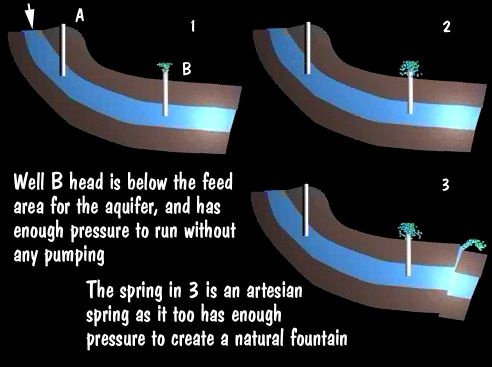(Latin for "water carrier".) Aquifers tend to be large bodies of ground water contained in a solid with high porosity and good permeability. They are often made up of sand, gravel, or poorly cemented sandstone.
Unconfined Aquifers
An unconfined aquifer has no aquiclude above it.
One of the largest is the "Great Planes" aquifer. It stretches from South Dakota to Texas, and supplies most of the irrigation water for the great planes states.
Overall an aquifer is inclined so water tends to be collected more at the head end (higher) and migrates to the lower end. Since this type of aquifer has no aquiclude above, it can also replenish or add water to lakes or rivers below its head.
As with most natural resources, the Great Planes aquifer has been declining in size for many years. It is being over pumped and water is being removed faster than it can refill. Those who see the effect first are those furthest from the recharge area.
The ground water at the furthest distance drops more rapidly as water is removed from high levels.

A confined aquifer has an aquiclude above and below. Kind of like the ice-cream in an ice-cream sandwich.
With this type of formation the water layer can build up substantial pressure if the water shed area is above the point of exit.
The well at the far left in this image will need to be pumped just like any normal well drilled down to the water table. The second well, will become an "artesian well" because the well head is far below the point at which the formation receives its water.
If the water in the system can find a natural route to the surface, then the resulting spring will be an "artesian spring" and will run freely under its own pressure.
Water in this type of system can exit for long periods of time as it moves from the recharge area to the furthest springs or wells.
Note: because a confined aquifer has a non permeable layer above and below, the area that supplies it with water must be at some distance. So local rain and weather will have little effect on it.
When ground water is removed from aquifers, the drop in water table may be sufficient to cause an associated drop in the land itself. When water under pressure is removed, the saturated sediment dries out, and the weight from above may be sufficient to compress the lower (now empty) layers. The land may subside producing fissures, trenches or sinking foundations.
One of the most famous is the Leaning Tower of Pisa.
The damage can sometimes be reversed if injection wells are used to reintroduce water into the strata.
Hard Water
Water that passes through many layers to reach the water table, or that moves over large vertical distances is likely to find soluble minerals to dissolve.
Water that contains concentrations of calcium and magnesium is called "hard water". Such water is poor at dissolving soap and detergents, and can deposit itself in plumbing. Especially hot water pipes where it often produces calcium or magnesium oxide deposits in the pipes.
Soft water is water free of calcium and magnesium and creates abundant lather with soap and detergents. It often has a high pH (somewhat alkaline) and feels greasy.
Pollution
Highly permeable rock is good at moving waste quickly into ground water. Less permeable (good porosity) rock can actually help purify contaminated water by holding it up long enough for bacteria to destroy the pollution.
Good porosity (lower permeability) can work in two ways, first by a filtration process which removes larger particles by trapping them in the pores, and secondly by creating a favorable environment for bacteria strains.
Buried industrial waste is another problem. Over time the containers themselves can be eroded and release their contents. Even dumps with liners (plastic or rubberized basins) wear out or can be breached by high surface water (rains and floods).
Groundwater meets Sea Water
There is a natural brackish zone between groundwater and sea water. This zone has less salt than ocean water but more salt than the original groundwater. Usually, groundwater has a higher "head of pressure" than sea water as it usually begins at a higher elevation.
Wells located near brackish water may produce cones of depression that override their freshwater pumping area and begin to pull in brackish or sea water.
| NEXT | TOC | PREV |